Satyapriya Krishna
Insights from the Inverse: Reconstructing LLM Training Goals Through Inverse RL
Oct 16, 2024



Abstract:Large language models (LLMs) trained with Reinforcement Learning from Human Feedback (RLHF) have demonstrated remarkable capabilities, but their underlying reward functions and decision-making processes remain opaque. This paper introduces a novel approach to interpreting LLMs by applying inverse reinforcement learning (IRL) to recover their implicit reward functions. We conduct experiments on toxicity-aligned LLMs of varying sizes, extracting reward models that achieve up to 80.40% accuracy in predicting human preferences. Our analysis reveals key insights into the non-identifiability of reward functions, the relationship between model size and interpretability, and potential pitfalls in the RLHF process. We demonstrate that IRL-derived reward models can be used to fine-tune new LLMs, resulting in comparable or improved performance on toxicity benchmarks. This work provides a new lens for understanding and improving LLM alignment, with implications for the responsible development and deployment of these powerful systems.
Operationalizing a Threat Model for Red-Teaming Large Language Models (LLMs)
Jul 20, 2024
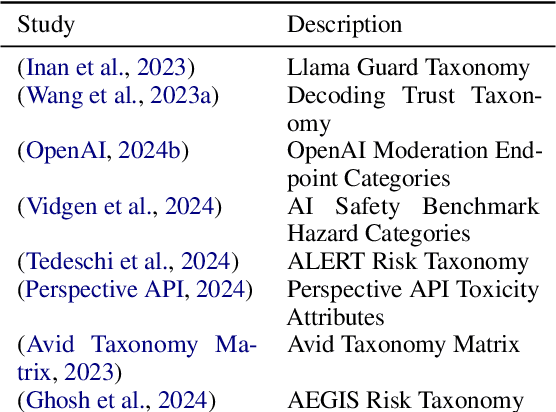

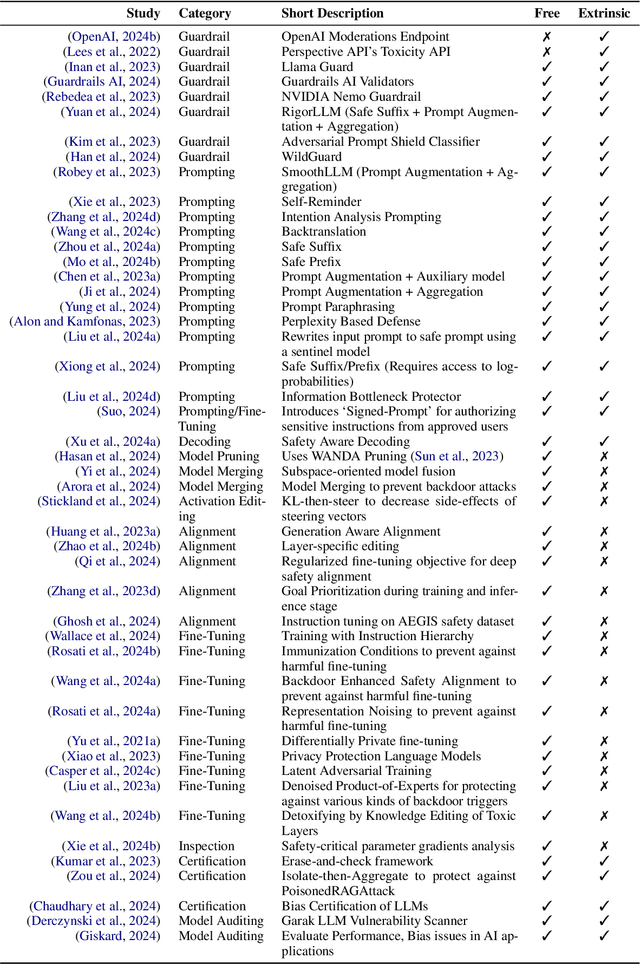
Abstract:Creating secure and resilient applications with large language models (LLM) requires anticipating, adjusting to, and countering unforeseen threats. Red-teaming has emerged as a critical technique for identifying vulnerabilities in real-world LLM implementations. This paper presents a detailed threat model and provides a systematization of knowledge (SoK) of red-teaming attacks on LLMs. We develop a taxonomy of attacks based on the stages of the LLM development and deployment process and extract various insights from previous research. In addition, we compile methods for defense and practical red-teaming strategies for practitioners. By delineating prominent attack motifs and shedding light on various entry points, this paper provides a framework for improving the security and robustness of LLM-based systems.
More RLHF, More Trust? On The Impact of Human Preference Alignment On Language Model Trustworthiness
Apr 29, 2024Abstract:The surge in Large Language Models (LLMs) development has led to improved performance on cognitive tasks as well as an urgent need to align these models with human values in order to safely exploit their power. Despite the effectiveness of preference learning algorithms like Reinforcement Learning From Human Feedback (RLHF) in aligning human preferences, their assumed improvements on model trustworthiness haven't been thoroughly testified. Toward this end, this study investigates how models that have been aligned with general-purpose preference data on helpfulness and harmlessness perform across five trustworthiness verticals: toxicity, stereotypical bias, machine ethics, truthfulness, and privacy. For model alignment, we focus on three widely used RLHF variants: Supervised Finetuning (SFT), Proximal Policy Optimization (PPO), and Direct Preference Optimization (DPO). Through extensive empirical investigations, we discover that the improvement in trustworthiness by RLHF is far from guaranteed, and there exists a complex interplay between preference data, alignment algorithms, and specific trustworthiness aspects. Together, our results underscore the need for more nuanced approaches for model alignment. By shedding light on the intricate dynamics of these components within model alignment, we hope this research will guide the community towards developing language models that are both capable and trustworthy.
Eagle and Finch: RWKV with Matrix-Valued States and Dynamic Recurrence
Apr 10, 2024



Abstract:We present Eagle (RWKV-5) and Finch (RWKV-6), sequence models improving upon the RWKV (RWKV-4) architecture. Our architectural design advancements include multi-headed matrix-valued states and a dynamic recurrence mechanism that improve expressivity while maintaining the inference efficiency characteristics of RNNs. We introduce a new multilingual corpus with 1.12 trillion tokens and a fast tokenizer based on greedy matching for enhanced multilinguality. We trained four Eagle models, ranging from 0.46 to 7.5 billion parameters, and two Finch models with 1.6 and 3.1 billion parameters and find that they achieve competitive performance across a wide variety of benchmarks. We release all our models on HuggingFace under the Apache 2.0 license. Models at: https://huggingface.co/RWKV Training code at: https://github.com/RWKV/RWKV-LM Inference code at: https://github.com/RWKV/ChatRWKV Time-parallel training code at: https://github.com/RWKV/RWKV-infctx-trainer
Understanding the Effects of Iterative Prompting on Truthfulness
Feb 09, 2024Abstract:The development of Large Language Models (LLMs) has notably transformed numerous sectors, offering impressive text generation capabilities. Yet, the reliability and truthfulness of these models remain pressing concerns. To this end, we investigate iterative prompting, a strategy hypothesized to refine LLM responses, assessing its impact on LLM truthfulness, an area which has not been thoroughly explored. Our extensive experiments delve into the intricacies of iterative prompting variants, examining their influence on the accuracy and calibration of model responses. Our findings reveal that naive prompting methods significantly undermine truthfulness, leading to exacerbated calibration errors. In response to these challenges, we introduce several prompting variants designed to address the identified issues. These variants demonstrate marked improvements over existing baselines, signaling a promising direction for future research. Our work provides a nuanced understanding of iterative prompting and introduces novel approaches to enhance the truthfulness of LLMs, thereby contributing to the development of more accurate and trustworthy AI systems.
Black-Box Access is Insufficient for Rigorous AI Audits
Jan 25, 2024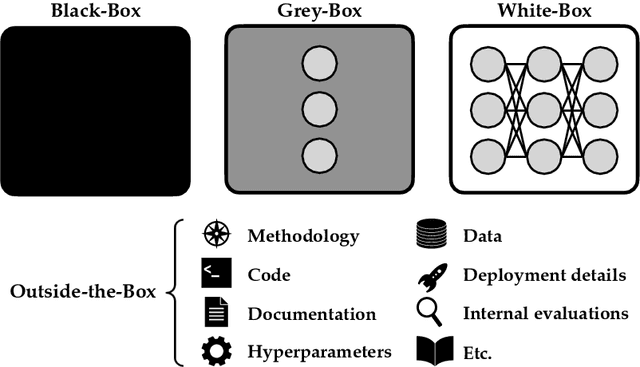
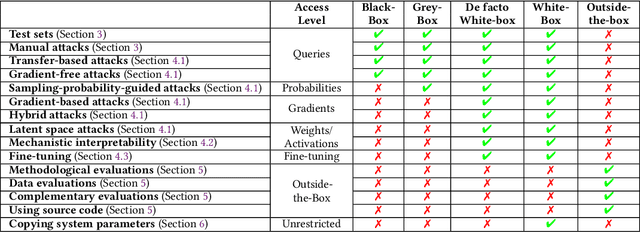
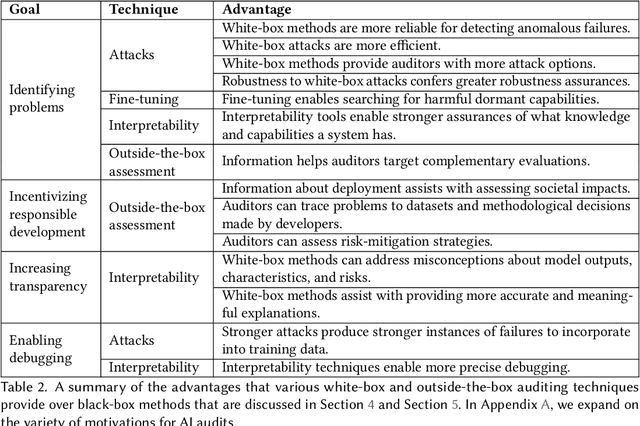
Abstract:External audits of AI systems are increasingly recognized as a key mechanism for AI governance. The effectiveness of an audit, however, depends on the degree of system access granted to auditors. Recent audits of state-of-the-art AI systems have primarily relied on black-box access, in which auditors can only query the system and observe its outputs. However, white-box access to the system's inner workings (e.g., weights, activations, gradients) allows an auditor to perform stronger attacks, more thoroughly interpret models, and conduct fine-tuning. Meanwhile, outside-the-box access to its training and deployment information (e.g., methodology, code, documentation, hyperparameters, data, deployment details, findings from internal evaluations) allows for auditors to scrutinize the development process and design more targeted evaluations. In this paper, we examine the limitations of black-box audits and the advantages of white- and outside-the-box audits. We also discuss technical, physical, and legal safeguards for performing these audits with minimal security risks. Given that different forms of access can lead to very different levels of evaluation, we conclude that (1) transparency regarding the access and methods used by auditors is necessary to properly interpret audit results, and (2) white- and outside-the-box access allow for substantially more scrutiny than black-box access alone.
On the Intersection of Self-Correction and Trust in Language Models
Nov 06, 2023



Abstract:Large Language Models (LLMs) have demonstrated remarkable capabilities in performing complex cognitive tasks. However, their complexity and lack of transparency have raised several trustworthiness concerns, including the propagation of misinformation and toxicity. Recent research has explored the self-correction capabilities of LLMs to enhance their performance. In this work, we investigate whether these self-correction capabilities can be harnessed to improve the trustworthiness of LLMs. We conduct experiments focusing on two key aspects of trustworthiness: truthfulness and toxicity. Our findings reveal that self-correction can lead to improvements in toxicity and truthfulness, but the extent of these improvements varies depending on the specific aspect of trustworthiness and the nature of the task. Interestingly, our study also uncovers instances of "self-doubt" in LLMs during the self-correction process, introducing a new set of challenges that need to be addressed.
Are Large Language Models Post Hoc Explainers?
Oct 10, 2023



Abstract:Large Language Models (LLMs) are increasingly used as powerful tools for a plethora of natural language processing (NLP) applications. A recent innovation, in-context learning (ICL), enables LLMs to learn new tasks by supplying a few examples in the prompt during inference time, thereby eliminating the need for model fine-tuning. While LLMs have been utilized in several applications, their applicability in explaining the behavior of other models remains relatively unexplored. Despite the growing number of new explanation techniques, many require white-box access to the model and/or are computationally expensive, highlighting a need for next-generation post hoc explainers. In this work, we present the first framework to study the effectiveness of LLMs in explaining other predictive models. More specifically, we propose a novel framework encompassing multiple prompting strategies: i) Perturbation-based ICL, ii) Prediction-based ICL, iii) Instruction-based ICL, and iv) Explanation-based ICL, with varying levels of information about the underlying ML model and the local neighborhood of the test sample. We conduct extensive experiments with real-world benchmark datasets to demonstrate that LLM-generated explanations perform on par with state-of-the-art post hoc explainers using their ability to leverage ICL examples and their internal knowledge in generating model explanations. On average, across four datasets and two ML models, we observe that LLMs identify the most important feature with 72.19% accuracy, opening up new frontiers in explainable artificial intelligence (XAI) to explore LLM-based explanation frameworks.
On the Trade-offs between Adversarial Robustness and Actionable Explanations
Sep 28, 2023Abstract:As machine learning models are increasingly being employed in various high-stakes settings, it becomes important to ensure that predictions of these models are not only adversarially robust, but also readily explainable to relevant stakeholders. However, it is unclear if these two notions can be simultaneously achieved or if there exist trade-offs between them. In this work, we make one of the first attempts at studying the impact of adversarially robust models on actionable explanations which provide end users with a means for recourse. We theoretically and empirically analyze the cost (ease of implementation) and validity (probability of obtaining a positive model prediction) of recourses output by state-of-the-art algorithms when the underlying models are adversarially robust vs. non-robust. More specifically, we derive theoretical bounds on the differences between the cost and the validity of the recourses generated by state-of-the-art algorithms for adversarially robust vs. non-robust linear and non-linear models. Our empirical results with multiple real-world datasets validate our theoretical results and show the impact of varying degrees of model robustness on the cost and validity of the resulting recourses. Our analyses demonstrate that adversarially robust models significantly increase the cost and reduce the validity of the resulting recourses, thus shedding light on the inherent trade-offs between adversarial robustness and actionable explanations
Towards Bridging the Gaps between the Right to Explanation and the Right to be Forgotten
Feb 10, 2023Abstract:The Right to Explanation and the Right to be Forgotten are two important principles outlined to regulate algorithmic decision making and data usage in real-world applications. While the right to explanation allows individuals to request an actionable explanation for an algorithmic decision, the right to be forgotten grants them the right to ask for their data to be deleted from all the databases and models of an organization. Intuitively, enforcing the right to be forgotten may trigger model updates which in turn invalidate previously provided explanations, thus violating the right to explanation. In this work, we investigate the technical implications arising due to the interference between the two aforementioned regulatory principles, and propose the first algorithmic framework to resolve the tension between them. To this end, we formulate a novel optimization problem to generate explanations that are robust to model updates due to the removal of training data instances by data deletion requests. We then derive an efficient approximation algorithm to handle the combinatorial complexity of this optimization problem. We theoretically demonstrate that our method generates explanations that are provably robust to worst-case data deletion requests with bounded costs in case of linear models and certain classes of non-linear models. Extensive experimentation with real-world datasets demonstrates the efficacy of the proposed framework.
 Add to Chrome
Add to Chrome Add to Firefox
Add to Firefox Add to Edge
Add to Edge